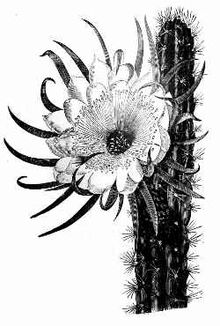Cereus repandus (syn. Cereus peruvianus), the Peruvian apple cactus, is a large, erect, spiny columnar cactus found in South America. It is also known as giant club cactus, hedge cactus, cadushi (inPapiamento and Wayuunaiki[2]), and kayush.
| Peruvian apple cactus | |
|---|---|

| |

| |
| Drawing of flowering stem | |
| Scientific classification | |
| Kingdom: | Plantae |
| Clade: | Tracheophytes |
| Clade: | Angiosperms |
| Clade: | Eudicots |
| Order: | Caryophyllales |
| Family: | Cactaceae |
| Subfamily: | Cactoideae |
| Genus: | Cereus |
| Species: |
C. repandus
|
| Binomial name | |
| Cereus repandus | |
| Synonyms | |
|
Cereus peruvianus | |
Cereus repandus is grown mostly as an ornamental plant, but has some local culinary importance. The Wayuu from the La Guajira PeninsulaofColombia and Venezuela also use the inner cane-like wood of the plant in wattle and daub construction.[2]
With an often tree-like appearance, its cylindrical gray-green to blue stems can reach 10 metres (33 feet) in height and 10–20 cm in diameter as a self-supporting plant. However, if supported by a scaffold, C. repandus has grown to a height of 110 feet (34 meters) at the SDM College of Dental Sciences at Dharwad, Karnataka, India,[3] technically making this the tallest cactus plant in the world, although no cactus under natural conditions exceeds eighty-two feet (25 meters) in height in the case of Cereus stenogonus.[4] There are nine to ten rounded ribs that are up to 1 centimeter high. The small areoles on it are far apart. The gray, needle-like thorns are very variable. They are often numerous, but can also be missing entirely. The longest thorns are up to 5 centimeters long.
The large, cream-colored, nocturnal flowers remain open for only one night and are of vital importance to pollinating bats. The fruits, known locally as pitaya, olala (only in some parts of Bolivia) or Peruvian apple, are thornless and vary in skin colour from violet-red to yellow. The edible flesh is white and contains small, edible, crunchy seeds. The flesh sweetens as the fruit opens out fully. As the cactus grows in arid regions and fruits in the dry seasons, the fruit is an essential source of food for birds in its native range.[5]